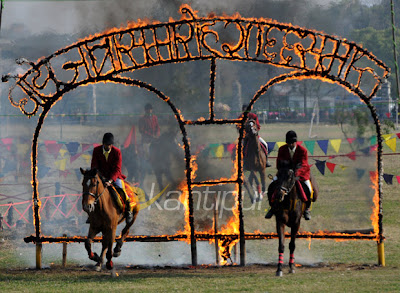 Holi(Sanskrit: होली), is a spring religious festival celebrated by Hindus and Sikhs. It is observed in N
Holi(Sanskrit: होली), is a spring religious festival celebrated by Hindus and Sikhs. It is observed in NThese places have become tourist destinations during the festive season of Holi, which lasts here to up to sixteen days.
The main day, Holi, also known as Dhuli Vandana in Sanskrit,also Dhulheti, Dhulandi or Dhulendi, is celebrated by people throwing coloured powder and coloured water at each other. Bonfires are lit the day before, also known as Holika Dahan (burning of Holika) or Chhoti Holi (little Holi). The bonfires are lit in memory of the miraculous escape that young Prahlad accomplished when Demoness Holika, sister of Hiranyakashipu, carried him into the fire. Holika was burnt but Prahlad, a staunch devotee of god Vishnu, escaped without any injuries due to his unshakable devotion. Phagu is another name for Holi where Phagu means the sacred red powder and Pune is the full moon day, on which the festival ends.
The days prior to the last don't have a lot happening except, the installation of the ceremonial pole called "chir', on the first day. It's a bamboo pole, fringed with strips of cloth representing good luck charms. It is said to symbolize the tree on which lord Krishna hung the milkmaids' garments while they were bathing, unseen as they thought, in the Jamuna river of northern India
 In Vaishnava Theology, Hiranyakashipu is the great king of demons, and he had been granted a boon by Brahma, which made it almost impossible for him to be killed. The boon was due to his long penance, after which he had demanded that he not be killed "during day or night; inside the home or outside, not on earth or on sky; neither by a man nor an animal; neither by astra nor by shastra". Consequently, he grew arrogant and attacked the Heavens and the Earth. He demanded that people stop worshipping gods and start praying to him. Despite this, Hiranyakashipu's own son, Prahlada, was a devotee of Lord Vishnu. In spite of several threats from Hiranyakashipu, Prahlada continued offering prayers to Lord Vishnu. He was poisoned but the poison turned to nectar in his mouth. He was ordered to be trampled by elephants yet remained unharmed. He was put in a room with hungry, poisonous snakes and survived. All of Hiranyakashipu's attempts to kill his son failed. Finally, he ordered young Prahlada to sit on a pyre on the lap of his demoness sister, Holika, who could not die because she also had a boon which would prevent fire from burning her. Prahlada readily accepted his father's orders, and prayed to Vishnu to keep him safe. When the fire started, everyone watched in amazement as Holika burnt to death, while Prahlada survived unharmed, the burning of Holika is celebrated as Holi.
In Vaishnava Theology, Hiranyakashipu is the great king of demons, and he had been granted a boon by Brahma, which made it almost impossible for him to be killed. The boon was due to his long penance, after which he had demanded that he not be killed "during day or night; inside the home or outside, not on earth or on sky; neither by a man nor an animal; neither by astra nor by shastra". Consequently, he grew arrogant and attacked the Heavens and the Earth. He demanded that people stop worshipping gods and start praying to him. Despite this, Hiranyakashipu's own son, Prahlada, was a devotee of Lord Vishnu. In spite of several threats from Hiranyakashipu, Prahlada continued offering prayers to Lord Vishnu. He was poisoned but the poison turned to nectar in his mouth. He was ordered to be trampled by elephants yet remained unharmed. He was put in a room with hungry, poisonous snakes and survived. All of Hiranyakashipu's attempts to kill his son failed. Finally, he ordered young Prahlada to sit on a pyre on the lap of his demoness sister, Holika, who could not die because she also had a boon which would prevent fire from burning her. Prahlada readily accepted his father's orders, and prayed to Vishnu to keep him safe. When the fire started, everyone watched in amazement as Holika burnt to death, while Prahlada survived unharmed, the burning of Holika is celebrated as Holi.In Vrindavan and
Holi for everyone is a time for fun and frolic. A day when one forgets the worldly anxieties and just enjoys the finer things in life.












